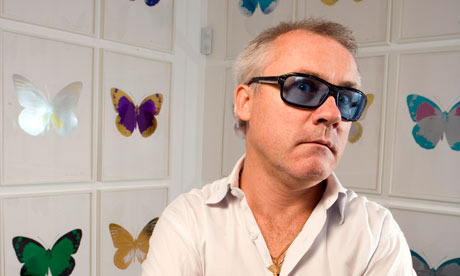
It's all been about housing this week, spearheaded by the surprise announcement of a new celebrity developer in the game: Damien Hirst. It turns out the zillionaire spot-merchant is planning to build 500 eco-homes on land he owns in glamorous Ilfracombe, Devon. It's early days – building won't start till next year – but his architect, Mike Rundell, spoke to locals about Hirst's plans this week, according to the North Devon Journal.
"He has a horror of building anonymous, lifeless buildings," Rundell told the meeting. "He wants these houses to be the kind of homes he would want to live in." Although seeing as Hirst bought Toddington Manor, a 300-room Gloucestershire mansion, a few years ago, that might be a bit of a stretch.
Rundell is clearly in with Hirst and the gang. He is also restoring Toddington Manor, and has designed art galleries including White Cube, which represents Hirst. And judging by his website, he has a healthy selection of cultured and well-heeled clients.
What's in store for Ilfracombe sounds encouraging so far: "We don't want to make anything pastiche but we need to take into account the themes of existing local buildings," Rundell said. "We hope to incorporate features such as pitched roofs, bay windows, smart gable ends, short terraces and robust materials used in a decorative manner." At the same time, they'll incorporate photovoltaic panels, concealed wind turbines and other environmental features, he pledged. No transparent glass boxes then? No jewel-encrusted platinum facades? Not even a combi-boiler sliced in half? Come on Damien, think it through!
If Hirst is looking for more inspiration, he could always pop into the RIBA's new Home Season, which kicked off yesterday with an exhibition on 250 years of British housing, from Georgian terraces through the industrial revolution, garden cities and modernist utopias to, er, poky new developments. Guest curated by Sarah "Property Ladder" Beeny, it's a window on to changing public tastes and trends as much as architectural ones. Especially noteworthy are the photographs, by the likes of Eric de Mare, John Maltby and Tony Ray-Jones, the latter of whom was chronicling the eccentricities of English life when Martin Parr was still in short trousers. Ray-Jones's snaps of bold new British projects of the 1960s retain a human element, juxtaposing huge new schemes like Thamesmead with the people who live in them, and casting a sceptical eye on the high-rise ambitions of the era.
Still with housing, and in the week that Le Corbusier's famed Unité d'Habitation, the mothership of modern mass housing, caught fire, new buildings rose from the ashes of London's less successful experiment in mass housing, the Heygate Estate. The demolition of this warren of concrete walkways and relentlessly monotonous apartment blocks could send the British film industry into a tailspin, as it's become the prime location for dystopian "this country's gone to the bleeding dogs" urban movies – as seen in Harry Brown, Shank, The Veteran and Attack the Block.
Ex-Heygate residents began moving into two smaller pieces of the huge Elephant and Castle regeneration this week, both designed by London-based Metaphorm. More romcom than urban thriller, you'd never guess they were affordable housing. The block on Brandon Street has a curving facade of hexagonal tiles in sunburst colours, with built-in public seating facing the street. A larger scheme on Library Street also features a curving facade, in different shades of brickwork, and a new green square. "Urbanity" was the key, say the architects.
Which brings us neatly on to Urbanized, the first of two documentary releases architecture-spotters should look out for this week. Made by Gary Hustwit, of design-geek classic Helvetica, and out now on DVD, it's a scattershot survey of the problems of designing cities the world over – and the inspiring solutions planners, architects, grassroots groups and even politicians have come up with.
Position Among the Stars, meanwhile, is the final instalment of an acclaimed, decade-spanning documentary trilogy on modern Indonesian life. That makes it sound eye-rollingly studious, when in fact it's an entertaining family saga with incredible camerawork and "structured reality" TV dynamics – The Only Way Is Jakarta? It also offers a sobering perspective on urban life in the world's fourth most populous country. No minimum space standards here: the cramped family home we see is in the middle of a dense labyrinth of alleyways, only accessible by foot (though the cameraman seems to have wings). Scooters swarm like bees down the city highways, rats scuttle in open sewers, fumigation teams surreally shroud the neighbourhood in thick clouds of insecticide and local bigwigs throw wads of cash into the streets to show off their largesse. Rather than some urban hell, though, Dutch director Leonard Retel Helmrich's film portrays it as a neighbourhood where life is chaotic (you have to fight through a scrum just to buy a new canister of cooking gas) but overwhelmingly harmonious. There's a lesson there.

